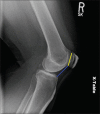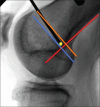Current Concepts in the Management of Patellar Instability
- PMID: 28966372
- PMCID: PMC5609370
- DOI: 10.4103/ortho.IJOrtho_164_17
Current Concepts in the Management of Patellar Instability
Abstract
Patellar instability is a common presenting clinical entity in the field of orthopedics. This not only can occur from baseline morphologic variability within the patellofemoral articulation and alignment, but also from traumatic injury. While conservative management is many times employed early in the treatment course, symptomatic patellar instability can persist. This article reviews the available indexed published literature regarding patellar instability. Given the debilitating nature of this condition and the long term sequelae that can evolve from its lack of adequate recognition and treatment, this article details the most current methods in the evaluation of this entity as well as reviews the most up-to-date surgical treatment regimens that are available to address this condition.
Keywords: Medial patellofemoral ligament; Patella; osteotomy; patella alta; patella femoral pain syndrome; patellar dislocation; patellar instability; tibial tubercle osteotomy; tibial tubercle-trochlear groove; trochlear dysplasia; trochleoplasty.
Conflict of interest statement
Dr. Diduch is a consultant for Depuy Synthes and receives royalties from Smith and Nephew; however, for the purposes of this review article, there are no gross conflicts of interest.
Figures








References
-
- Fithian DC, Paxton EW, Stone ML, Silva P, Davis DK, Elias DA, et al. Epidemiology and natural history of acute patellar dislocation. Am J Sports Med. 2004;32:1114–21. - PubMed
-
- Arendt EA, Fithian DC, Cohen E. Current concepts of lateral patella dislocation. Clin Sports Med. 2002;21:499–519. - PubMed
-
- Atkin DM, Fithian DC, Marangi KS, Stone ML, Dobson BE, Mendelsohn C, et al. Characteristics of patients with primary acute lateral patellar dislocation and their recovery within the first 6 months of injury. Am J Sports Med. 2000;28:472–9. - PubMed
-
- Nietosvaara Y, Aalto K, Kallio PE. Acute patellar dislocation in children: Incidence and associated osteochondral fractures. J Pediatr Orthop. 1994;14:513–5. - PubMed
-
- Elias DA, White LM, Fithian DC. Acute lateral patellar dislocation at MR imaging: Injury patterns of medial patellar soft-tissue restraints and osteochondral injuries of the inferomedial patella. Radiology. 2002;225:736–43. - PubMed
LinkOut - more resources
Full Text Sources
Other Literature Sources
